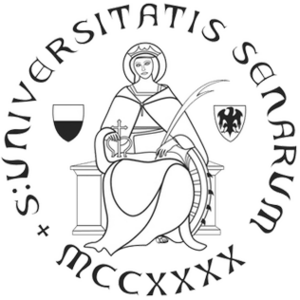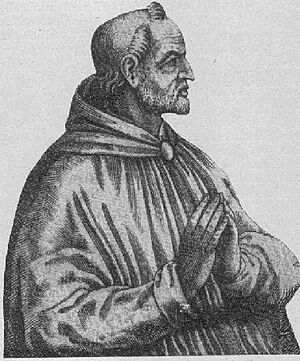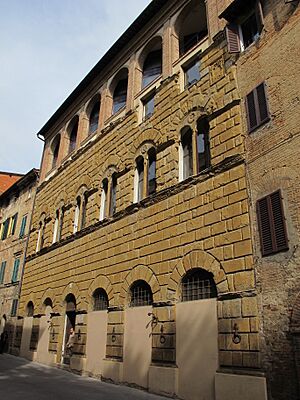University of Siena facts for kids
|
Università degli Studi di Siena
|
|
 |
|
| Latin: Universitatis Senarum | |
| Type | Public |
|---|---|
| Established | 1240 |
| Rector | Roberto Di Pietra |
| Students | 15,589 (academic year 2021-22) |
| Location |
,
Italy
43°19′9″N 11°19′57″E / 43.31917°N 11.33250°E |
| Campus | Both Urban/University town and suburban |
| Sports teams | CUS Siena |
| Affiliations | Coimbra Group IRUN |
The University of Siena (also known as UNISI) is a very old and important university in Siena, Tuscany, Italy. It was first started in 1240 as Studium Senese. This makes it one of the oldest universities in the world. It was also Italy's first university to be funded by the public.
Today, the University of Siena is home to around 16,000 students. This is a large number, as it's almost one-third of Siena's total population. The university is especially well-known for its excellent programs in law, medicine, and business studies.
Contents
History of the University
How the University Started
The University of Siena began way back on December 26, 1240. On that day, the leader of Siena, Ildebrandino Cacciaconti, signed a special rule. This rule said that people in Siena who rented rooms to students had to pay a tax. The money from this tax was used to pay the teachers (called maestri) at the new school, the Studium Senese.
The school got even more help in 1252. Pope Innocent IV announced that the teachers and students were free from taxes. They also didn't have to do forced work for the city. Teachers of law and Latin were even excused from military service. By the early 1300s, the school had many teachers. They taught subjects like Latin, logic, law, and natural sciences (medicine).
One famous teacher at the School of Medicine was Pietro Ispano. He was a smart thinker and a doctor for Emperor Frederick II. Later, in 1276, he became Pope John XXI.
In 1321, many students came to Siena from the famous University of Bologna. This happened because a student in Bologna was wrongly sentenced to death. The students protested, and Siena offered them a place to study. The local government helped pay for these new students.
The University Through Different Eras
The Studium in Siena became an official "Studium Generale" in 1355. This happened after Charles IV became Holy Roman Emperor. This new status meant that teachers and students were protected by the emperor. It also meant that degrees from Siena were recognized everywhere in Europe. This allowed graduates to teach anywhere in Christendom.
In the early 1400s, a building called the Casa della Sapienza was built. This building had classrooms and places for students to live. It was finished in 1412, and students moved in by 1416.
By the mid-1300s, Siena's power in Tuscany started to fade. Florence became more powerful and defeated Siena in 1555. However, the city leaders asked the Medici family, who ruled Florence, to keep the university going. The Medici rulers made changes to improve the university. They also created the position of Rettore (Rector), who was chosen by students and city leaders.
Later, in 1737, the French House of Lorraine took over Tuscany. During this time, a Tuscan economist named Sallustio Bandini helped the university. He found money for student scholarships. He also created a large library, which he later gave to the university.
In 1808, French forces took over Tuscany. They closed the Studium Senese. The university did not open again until after Napoleon's defeat. It reopened when Ferdinand III became the Grand Duke of Tuscany again.
The University During Italy's Unification
During the Risorgimento, which was the movement to unite Italy, students in Siena were very patriotic. They showed their support for a united Italy. In April 1848, three professors, one assistant, and fifty-five students formed a group. They joined battles to help create the new Italian republic. Their flag is still kept at the university today.
Because of this strong support for the new republic, the Grand Duke closed the School of Medicine. Only Law and Theology studies were allowed to continue.
After the Second Italian War of Independence in 1859, Tuscany became part of the Kingdom of Italy. The university slowly recovered. The city's businesses helped, and new laws boosted the reputation of the Pharmacy and Obstetrics schools. The old hospital, Santa Maria della Scala, became a university hospital. In 1880, the Law Faculty started the Circolo Giuridico, a group for studying law through seminars and talks.
The University in Modern Italy
In 1892, the Minister of Public Education, Ferdinando Martini, suggested closing the University of Siena. The people of Siena saw this as a big problem. They went on strike, and all the town's groups protested. This public outcry made the minister change his mind.
After this, Siena continued to invest in its university. They created new degrees and new departments. The bank Monte dei Paschi di Siena even paid for a new biology department.
The 1900s saw a lot of growth for the University of Siena. The number of students grew from about 400 to more than 15,000 in recent years.
Notable People from the University
Many important people have studied or taught at the University of Siena. Here are a few:
- Pietro Ispano (around 1215–1277), who became Pope John XXI, was a Professor of Medicine.
- Cino da Pistoia (1270–1336/37), a Professor of Law.
- Giovanni Maria Ciocchi del Monte (1487–1555), who became Pope Julius III, studied law here.
- Fabio Chigi, who became Pope Alexander VII.
- Virginia Angiola Borrino (1880–1965), was a Professor of Medicine. She was the first woman to lead a University Pediatric Ward in Italy.
- Carlo Rosselli (1899–1937), a political leader and writer who was against fascism.
- Norberto Bobbio (1909–2004), a Professor of Philosophy.
- Antonio Tabucchi (1943–2012), a famous Italian writer.
- Gianna Nannini (born 1954), a well-known Italian pop singer.
How the University is Organized
Since 2012, the University of Siena has fourteen departments. These departments are grouped into four main areas:
- Biomedical and Medical Sciences
- Department of Medical Biotechnologies
- Department of Molecular and Developmental Medicine
- Department of Medicine, Surgery and Neuroscience
- Economics, Law and Political Sciences
- Department of Economics and Statistics
- Department of Law
- Department of Political and International Sciences
- Department of Business and Law
- Experimental Sciences
- Department of Biotechnology, Chemistry and Pharmacy
- Department of Information Engineering and Mathematics
- Department of Life Sciences
- Department of Physical Sciences, Earth and Environment
- Literature, History, Philosophy and the Arts
- Department of Philology and Literary Criticism
- Department of Social, Political and Cognitive Sciences
- Department of History and Cultural Heritage
Each department offers courses for both undergraduate (first degree) and graduate (advanced degree) students.
The University of Siena's campus is actually the city of Siena itself. About 15,600 students live among the 53,000 people in Siena. The university is proud of its diverse student body.
The university has also helped save many old buildings in the city. For example, the Engineering and Literature departments are now in the large rooms of what used to be the San Niccolò Psychiatric Hospital. Another old convent, Santa Chiara, became the first student residence in Italy for European postgraduate students. The church of San Vigilio serves as the university's chapel.
New university buildings have also been built in the city center. The Faculty of Political Science and Law is in one of these new buildings. The university also has ten dormitories for students. These are located both in the historical center and on the outskirts of the city.
What You Can Study
For the academic year 2022–23, the University of Siena offered many different courses. Here are some of the main areas of study:
- Biotechnologies, Medicine, Dentistry, Health Professions
- You can study things like Biomedical laboratory techniques, Nursing, Physiotherapy, and Speech and language therapy.
- For longer studies, you can get degrees in Dentistry and Medicine and Surgery.
- Economics, Law, Political Sciences, Social Sciences
- Courses include Communication sciences, Economics and banking, Legal services, and Political sciences.
- You can also study International accounting and management, Finance, and International studies.
- A longer course is available for a degree in Law.
- Environmental Sciences, Biology, Chemistry, Pharmacy, Geology
- Here you can learn about Biological sciences, Chemical sciences, Geological sciences, and Natural and environmental sciences.
- Advanced studies include Biology, Chemistry, and Pharmaceutical biotechnology.
- Longer courses are available for Pharmaceutical chemistry and technology, and Pharmacy.
- Physics, Engineering, Mathematics
- This area offers courses like Computer and information engineering, Mathematics, and Physics.
- For advanced studies, you can learn about Applied mathematics, Artificial intelligence and automation engineering, and Electronics and communications engineering.
- Cultural Heritage, Education, Literature, Languages, History, Philosophy
- You can study Education, History and cultural heritage, and Languages for communication.
- Advanced courses include Archaeology, History of art, and Philosophy.
Places to See
- Orto Botanico dell'Università di Siena, which is the university's own botanical garden. It's a great place to see different plants.
See also
 In Spanish: Universidad de Siena para niños
In Spanish: Universidad de Siena para niños
- Coimbra Group (a group of important European universities)
- List of medieval universities
- List of Italian universities
- Siena
- WebCrow



